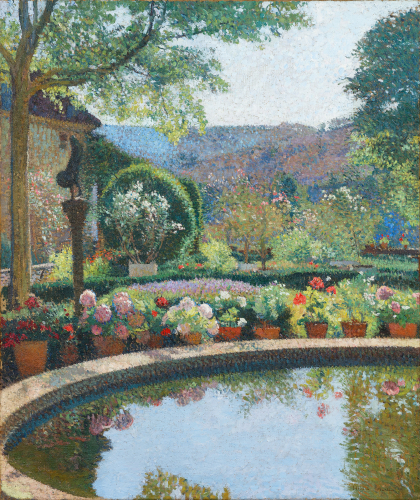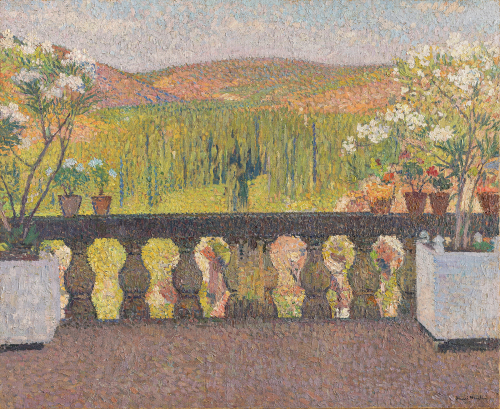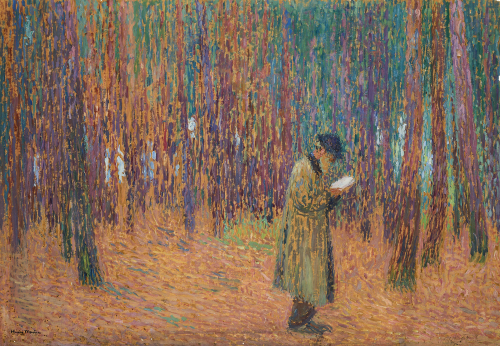
FAB 2024, Tribute to Henri Martin (1860-1943)
Henri Martin at Marquayrol: the painter in his garden
As part of its forthcoming participation in FAB (Fine Arts Paris La Biennale), to be held at the Grand Palais from 22 to 27 November 2024, the gallery will be devoting part of its stand to the work of Henri Martin. Several of the painter's canvases will be on display, in a scenography that will include personal objects that once belonged to Henri Martin, notably a work desk designed by his friend Henri Bellery-Desfontaines, which was previously kept by the artist's family.
In 1899, Henri Martin acquired a large estate of almost 30 hectares in Labastide-du-Vert, in the Lot department. The studio he had built on the hill overlooking the Vert valley offered spectacular views. The surroundings of the house have also been designed as small theatres. The light, sometimes golden in autumn, brighter in spring, and sometimes snow, dress up these settings: the pergolas and vines, the three ponds, the gate, the terrace, the opening into the garden from the house, all become recurring motifs in the painter's work, selected fragments that give him the opportunity to exercise his palette and his brushes. Henri Martin seemed to have found everything he needed at Marquayrol, and from 1923 onwards, he never really left the house, where until then he had spent only part of the year, from spring to autumn. Like Monet at Giverny, and his friend Le Sidaner at Gerberoy, Henri Martin saw his estate as an inexhaustible field of pictorial interest, to which he remained attached for the rest of his life.
Such is the importance of these gardens in the painter's work that a very large number of his paintings are devoted to them, variations in which the light flickers lightly on the foliage or spreads over the red vine, which is dying for the season.
Around the half-moon-shaped pool that faces the house, the coping is dotted with pots of geraniums, like so many red and pink ornaments in the buttonhole of an exuberantly green suit. The sculpture of a Child with a Goose also stands on its pedestal, a Roman replica of a Greek statue whose reproduction was so fashionable in the 19th century that it was chosen to adorn the banks of the Marquayrol pool.
Today, more than eighty years after the artist's death, Henri Martin's gardens are coming back to life thanks to a group of enthusiasts united around the estate's new owners. Long left to their own devices, the painter's colourful flowerbeds are being brought back to life, almost identically, thanks to... paintings! From ephemeral models, the flowers, once painted, have attained immortality and can in turn breathe new life into the settings imagined by Henri Martin.
An exceptional desk designed by Henri Bellery-Desfontaines
The very name Henri Bellery-Desfontaines sounds like the floral, sinuous lines of Art Nouveau, to which he lent his pen as illustrator, painter, decorator and designer. He died accidentally in the prime of life, and had not taken any of the steps that artists take when they reach maturity, with a view to leaving their mark on the fabric of future generations.
Trained by Jean-Paul Laurens, he attended the master's studio a few years later than Henri Martin. Despite this gap, the two artists became friends, which was no mean feat for Henri Martin, who believed in friendship as a cardinal virtue.
It goes without saying that this complicity was fuelled by artistic emulation, and the two Henri painted portraits of each other. Bellery-Desfontaines painted his eldest, palette in hand, in front of two paintings with symbolist features that he had just completed, in a large canvas kept by the Musée Henri Martin in Cahors. Henri Martin, for his part, painted small portraits of his friend, most of which were preliminary studies (as was often the case with the artist) for large-scale decors. A life-size Bellery-Desfontaines, attentive to the lessons of his master Laurens, strides forever along the banks of the Garonne, in a panel for the grand décor of the Capitole de Toulouse (Les rêveurs). He also represented him in the commission he carried out for the Sorbonne.
The collaboration between the two artists extended beyond the realm of painting. Indeed, Bellery-Desfontaines did not exercise his talents solely as a painter: in 1898, he exhibited pieces of furniture for the first time at the Salon des Artistes français.
His friend Docteur Tissier then commissioned a complete set of furniture, a salon, which was exhibited at the 1900 Universal Exhibition.
For his friend Henri Martin, Bellery-Desfontaines designed frames that were both sober and majestic, architecturally designed like temples, in which snatches of the modern style in vogue flourished, in sculpted ornaments that remarkably matched the motifs of the paintings. In 1908, again for his painter friend, he designed a desk. The desk has remained in the artist's family ever since.


The Solitary Walker, study for the grand décor of the Council of State
Tall trees take centre stage in the General Assembly Chamber of the Council of State. They presided over the opening of the session, in a decorative programme by Henri Martin that alternated between depicting manual labour and intellectual work on the walls.
Agricultural, working-class France, open to maritime trade, was thus presented to the Council, which had the onerous task of judging its laws. In contrast to the abundance of colours and characters, and the intense life that emanates from the compositions inspired by hard work (Agriculture, Commerce and Public Works), the figure with the long white beard who embodies intellectual work walks headlong through an autumnal undergrowth. With him comes a time of silence, of the quietude essential to intellectual creation, of contemplation. Intellectual work is thus seen as a priestly path.
This forest is reminiscent of Henri Martin's Symbolist period, anchoring the legends and poems that long inhabited his thoughts. The unchanging, secular, reclusive forest is a place of memory. Here, it takes on the tones of interiority that lead the character's footsteps towards these solid, upright trunks, which rise towards the heavens like sentinels of reason. Viennot, a friend of Henri Martin who worked at the Bibliothèque Nationale, was the model for this figure with a mysterious aura.
A heavy responsibility weighs on his experienced shoulders. Impervious to outside stimuli, he seems, on the other hand, to be soaking up the wisdom of the trees as he walks alone, taking advice from them as he does from his book, in a singular communion. In the final version of the large set, the figure's hands are clasped behind his back around his book, reinforcing the sense of introspection in the composition.
